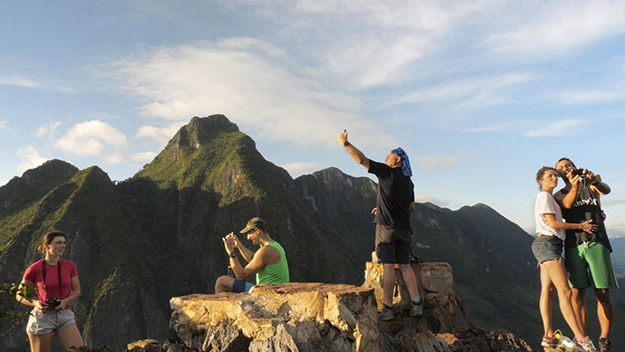Onlookers (Kimi Takesue, 2023) Over the last two decades, poetic or subjective nonfiction has become one of the most prevalent forms of avant-garde filmmaking. Artists like Kevin Jerome Everson, Ben Russell, Jodie Mack, Fox Maxy, Ja’Tovia Gary, and the members of Harvard’s Sensory Ethnography Lab have focused their creative energies on applying unconventional formal strategies to filmic facticity, reimagining the contours of both documentary and experimental cinema. In recognizing such work as worthy of a showcase all its own, the Prismatic Ground festival, founded and programmed by Inney Prakash, is both confirming and expanding this salutary trend. Despite being hosted by some of New York City’s best independent theaters (this year’s edition, the third, screens at the Museum of the Moving Image, the Maysles Documentary Center, BAM Cinematheque, DCTV’s Firehouse Cinema, Light Industry, and Anthology Film Archives), Prismatic Ground remains a relatively small-scale fest. Its curatorial purview, however, has been consistently broad and refreshingly open from its first iteration as a free, global, streaming-only fest in 2021. That inaugural edition spotlit filmmakers like Maxy, Angelo Madsen Minax, and Tiffany Sia, who went on to garner wider critical attention; last year’s lineup included groundbreaking and difficult-to-classify films like Rainer Kohlberger’s psychotropic Answering the Sun and Joële Walinga’s Foucaultian landscape project, Self-portrait. The 2023 edition is even wider in scope. The lineup includes recently restored experimental efforts like Raphael Montañez Ortíz’s 1958 poultry apocalypse Henny Penny: The Sky Is Falling and Maike Höhne’s 1998 Cuba-set sex-work study Fin de siglo; tribute screenings of Michael Snow’s debut film A to Z (1956) and Takahiko Iimura’s A Chair (1970); and a diverse array of bold new work, including a few by big-name artists. Among these are two projects by modern master Tsai Ming-liang, who has recently been channeling his familiar preoccupations—flatness versus depth, urban anomie, conflicting temporalities—into works that could be described as formalist tone poems. Tsai’s newest feature, entitled Where, is another installment in his “Walker” series, in which his perpetual muse, Lee Kang-sheng, moves through city centers in a Buddhist monk’s robe at an excruciatingly slow pace. Exhibiting astonishing bodily discipline, Lee creeps through the frame, painstakingly out of step with the everyday life rushing around him. Tsai constructs meticulous outdoor compositions in which Lee’s saffron-swaddled form stands out like a Christo and Jeanne-Claude sculpture. Tsai’s other film in the festival is a short made for Where Do You Stand?, an ongoing series commissioned by the Centre Pompidou that asks various directors to produce informal self-portraits. Here, Tsai shows us around his home, with particular focus on a waterlogged concrete storage structure containing his collection of mismatched chairs, Tsai’s paintings of those chairs, and other canvases based on images from his 2020 feature Days. The film is almost entirely composed of still shots of inert objects, lending it the feeling of a contemplative, sun-dappled slide show. This serves to place greater emphasis on movement when it occurs—most often courtesy of Tsai’s photogenic orange tabby. Like Tsai, the Portuguese duo of João Pedro Rodrigues and João Rui Guerra da Mata have contributed a profoundly sensual film exploring the particulars of cinematic space. Where Is This Street? or With No Before or After is something of a spiritual sequel to their last joint feature, 2012’s The Last Time I Saw Macao. Where that film examined the space and architecture of the titular city-state (until 1999 a Portuguese colony), Where Is This Street? considers Rodrigues and Guerra da Mata’s hometown of Lisbon. Shot during the COVID-19 lockdown, the film is both a work of landscape photography and a study in cinematic hauntology. After discovering that Paulo Rocha’s The Green Years, a seminal classic of Portuguese cinema, was shot on their street in 1963, the duo took advantage of the vacant city to revisit many of the avenues and locations featured in The Green Years, sometimes reproducing specific shots from Rocha’s film, sans actors. With its broad exterior tracking shots and playful retracing of time-weathered interiors, the film coalesces into a kind of urban anthropology, akin to Chantal Akerman’s From the East (1993), albeit soaked in Iberian sunshine. For me, the biggest discovery of this year’s Prismatic Ground was a cinematic triptych by multimedia artist Ayanna Dozier entitled “Close, but no Cigar.” The works in this series feature the artist recreating moments from campy ’70s and ’80s sexploitation films and garish TV advertisements: Dozier soaks in a heart-shaped tub in lovertits, devilishly peels and eats a hard-boiled egg in A Picture for Parko, and rides a children’s coin-op pony in an exercise in parting. Stripped of context, these short films become explorations and subversions of the gender codes invoked by the originals. Understanding the specific references is not necessary; playing to the camera, Dozier points to the de facto sexualization of Black women’s bodies in a culture of racist images. The feature documentary Onlookers, a wry and at times uproarious ethnographic work by Kimi Takesue, is nearly as revelatory. Formally reminiscent of the films of Nikolaus Geyrhalter, Onlookers presents the viewer with a series of modular, fixed-frame images of both locals and tourists in Laos. With exacting compositions, Takesue observes tourists as they seek the physical artifacts of Buddhism—temples, statues, monks at work—lured by the promise of Eastern exoticism. Meanwhile, everyday Laotians go about their business, fully aware that, to the paying visitors, they are part of the scenery. With its deft use of off-screen space (stately images of Buddhist architecture keep getting “ruined” by the arrival of backpackers and shutterbugs), Onlookers provides a piercing and ironic examination of seemingly benevolent cultural consumption. Like Dozier’s work, it exemplifies the aesthetic spirit of Prismatic Ground: one rooted in an understanding of experimental documentary as not so much a genre as an ethic. Nonfiction is a messy affair, and the most compelling films in its ambit are those that dive into confusion and keep on digging. Michael Sicinski is a writer and teacher based in Houston, Texas.
